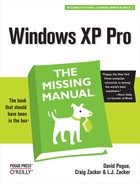As any Windows 2000 user can tell you, stability has its price. For years, people who ran Windows 2000 enjoyed far fewer system crashes than Windows Me people did—but they were limited to a much smaller set of compatible programs. (Barney the Dinosaur CDs, for example, simply wouldn’t run on Windows 2000.)
Although it’s based on Windows 2000, Windows XP isn’t quite as limiting to your software library. Microsoft has pulled every trick in the book to make older, pre Windows XP programs run successfully. For example:
A 16-bit program is one that’s so old, it was written when Windows 3.1 roamed the earth and George Bush Sr. was president. (Programs written for Windows 95 and later are known as 32-bit programs.) Bit amazingly enough, even Windows XP can run most of these programs. It does so in a kind of software simulator—a DOS-and-Windows 3.1 PC impersonation called a virtual machine.
As a result, these programs don’t run very fast, they don’t understand the long filenames of the modern-day Windows, and they may crash whenever they try to “speak” directly to certain components of your hardware (the simulator stands in their way, in the name of keeping Windows XP stable). Furthermore, if just one of your 16-bit programs crashes, all of them crash, because they all live in the same memory bubble.
Even so, it’s impressive that they run at all, ten years later.
These programs are 16-bit programs, too, and therefore they run just fine in Windows XP, even though DOS no longer lurks beneath the operating system.
To open the black, empty DOS window that’s familiar to longtime PC users, choose Start→All Programs→Accessories→Command Prompt. (See Section 6.1.4.2.)
In principle, programs that were written for recent versions of Windows should run fine in Windows XP. Unfortunately, some of them contain software code that deliberately sniffs around to find out what Windows version you have. These programs (or even their installer programs) may say, Windows what?“—and refuse to run.
Fortunately, the Properties box of every program (or program shortcut) offers you the opportunity to fool such programs into believing that they’re running on a Windows 95 machine, Windows 2000 machine, or whatever. Figure 5-19 details the process, but a few footnotes are in order:
Figure 5-19. If you’ve successfully installed an older program that doesn’t seem to work in Windows XP, find its application icon as described in Section 17.2.2. Right-click the icon and choose Properties from the shortcut menu. In the Properties dialog box, click the Compatibility tab, turn on “Run this program in compatibility mode for,” and then, using the drop-down menu of past Windows versions, choose the version you suspect will make your program happiest. When you click OK, Windows XP will try to fake out the program, making it run. Your dialog box may differ slightly from the one you see here, depending on the program you are trying to run.
You’re much better off securing an updated version of the program, if it’s available. Check the program’s Web site to see if an XP-compatibility update is available.
Don’t try this trick with utilities like virus checkers, backup programs, CD burning software, and hard drive utilities. Installing older versions of these with Windows XP is asking for disaster.
If the program you’re trying to run is on a CD or on a hard drive elsewhere on the network, you won’t be able to change its properties using the steps described in Figure 5-19. Instead, choose Start→All Programs→Accessories→Program Compatibility Wizard. A series of wizard screens explains the concept of compatibility-fooling, and then lets you choose the program you’d like to fool.

